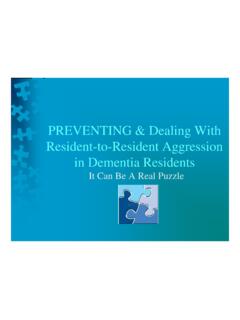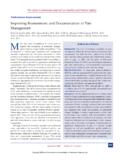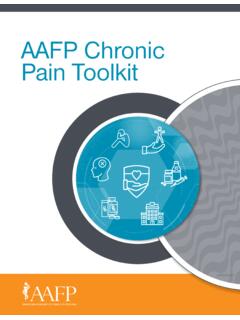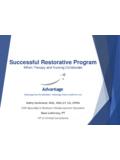Transcription of Bowel and Bladder Function - Kansas Health Care Association
1 Bowel and Bladder FunctionHOW TO DEVELOP AN EFFECTIVE SCHEDULED TOILETING PROGRAM AS A FALL REDUCTION PROGRAMO bjectives Participants will be able to verbalize understanding of how development of effective toileting plans can reduce fall risks Participants will be able to verbalize how to conduct a Bowel and Bladder Assessment and 3-day Elimination Assessment and development of an effective toileting schedule from gathered data Participants will be able to verbalize understanding of Bladder Habit Training, Prompted Toileting and Scheduled Voiding ProtocolsIncontinence and/or Urgency While urinary incontinence is more prevalent with age, it is not a natural part of aging, says Liz Jensen, RN, MSN, RN-BC, clinical director at Direct Supply.
2 Comprehensive, person-centric assessments and an interprofessional approach to care planning can help many residents who experience incontinence either reduce the number of episodes per day or restore continence altogether, while reducing risk of falls. Studies show almost 50% of falls are related to toileting Common urologic conditions associated with falls include: Lower UTIs Urinary incontinence Overactive Bladder Prostatic diseases Lower urinary tract tumorsThe Relationship Between Incontinence & Accidental Falls Incontinence episodes may lead to slips on wet floor surfaces Urge incontinence may increase fall risk when a person hurries to the toilet, especially in unfamiliar, cluttered or dark areas Episodes of urinary incontinence may be transitory and often related to acute illness, such as urinary tract infections that can cause incontinence, delirium, drowsiness and hypotension Medications used to treat incontinence, such as anticholinergics or alpha blockers.
3 Can cause postural hypotension Waking up to urinate at night can result in poor sleep, which is associated with increased fall risk Making frequent bathroom trips at night, through a poorly lit or obstructed pathway, may increase fall riskF690 Incontinence The facility must ensure that a resident whois continent of Bladder and Bowel on admission receives services and assistance to maintain continence unless his or her clinical condition is or becomes such that continence is not possible to maintain. (e)(2)For a resident with urinary incontinence, based on the resident s comprehensive assessment, the facility must ensure that (i) A resident who enters the facility without an indwelling catheter is not catheterized unlessthe resident s clinical condition demonstrates that catheterization was necessary.
4 (ii) A resident who enters the facility with an indwelling catheter or subsequently receives one is assessed for removal of the catheter as soon as possible unless the resident s clinical condition demonstrates that catheterization is necessary and (iii) A resident who is incontinent of Bladder receives appropriate treatment and services to prevent urinary tract infections and to restorecontinence to the extent possible. (e)(3) For a resident with fecal incontinence, based on the resident s comprehensive assessment, the facility must ensure that a resident who is incontinent of Bowel receives appropriate treatment and services to restore as much normal Bowel Function as Intent The intent of this requirement is to ensure that: Each resident who is continent of Bladder and Bowel receives the necessary services and assistance to maintain continence, unless it is clinically not possible.
5 Each resident who is incontinent of urine is identified, assessed and provided appropriate treatment and services to achieve or maintain as much normal Bladder Function as possible; A resident who is incontinent of Bowel is identified, assessed and provided appropriate treatment and services to restore as much normal Bowel Function as possible; An indwelling catheter is not used unless there is valid medical justificationfor catheterizationandthe catheter is discontinued as soon as clinically warranted; Services are provided to restore or improve normal Bladder Function to the extent possible, after the removal of the indwelling catheter; and A resident, with or withoutan indwellingcatheter, receives the appropriate care and services to preventurinary tractinfections to the extent Urinary Incontinence is the involuntary loss or leakage of urine.
6 There are several types of urinary incontinence, and the individual elder may experience more than one type at a time. Some of the more common types include: Functional Incontinence: urinary tract intact but resident cannot remain continent because of external factors Mixed Incontinence: combination of urge incontinence & stress incontinence Overflow Incontinence: associated with leakage of small amounts of urine when Bladder has reached capacity Stress Incontinence: Outlet incompetence; associated with impaired urethral closure Transient Incontinence: temporary or occasional incontinence that may be related to a variety of temporary causes ( , medications, delirium, infection, vaginitis, restricted mobility, fecal impaction) Urge Incontinence: Associated with detrusor muscle over activity: abrupt urgency, frequency & nocturiaF690 Interventions Managing pain and/or providing adaptive equipment to improve Function for residents suffering from arthritis, contractures, neurological impairments, etc.
7 ; Removing or improving environmental impediments that affect the resident s level of continence ( , improved lighting, use of a bedside commode or reducing the distance to the toilet); Treating underlying conditions that have a potentially negative impact on the degree of continence ( , delirium causing urinary incontinence related to acute confusion); Possibly adjusting medications affecting continence ( , medication cessation, dose reduction, selection of an alternate medication, change in time of administration); and Implementing a fluid and/or Bowel management program to meet the assessed Interventions: Behavioral Programs NOTE:It is important for the comprehensive assessment to identify the essential skills the resident must possess,such asthe resident s ability to: comprehend and follow instructions; identify urinary urge; control the urge to void until reaching a toilet; and/or respond to prompts to void.
8 Voiding records help detect urinary patterns or intervals between incontinence episodes and facilitate planning care to avoid or reduce the frequency of episodes. Bladder Rehabilitation / Bladder Retraining Pelvic Floor Muscle Rehabilitation Prompted Voiding Habit Training/Scheduled VoidingOther Potential Interventions Toilets/Commodes Correct height Have grab bars Close as possible to bed Arrange room to facilitate safe independence as appropriate Floors dry & pathway is uncluttered & unobstructed Eliminate tethers Oxygen Catheter tubing (Consider leg bags during day) IV tubing Feeding tube cords Medical Treatments Pessary Hormone therapy Surgery Anticholinergics or alpha-agonists Therapy Services Have OT make recommendations for structural updates Have all incontinent residents evaluated by PT to determine if neuromuscular retraining is possible Pelvic floor exercises Electro-stimulator therapyAssessment documentation Specific designation of type of incontinence Substantiation of elder s fluid & hydration status Documentation substantiating risks &/or conditions affecting incontinence.
9 NeurologicalCognitivePhysical Function Sensory impairmentsResisting careDepression StrokeDiabetesParkinson s disease History of UTIP rolapsed uterusBPH ObesityHistory of urinary retention History of fecal impaction PainDietary Factors End of lifePresence of pressure ulcer(s)Assessment documentation (cont) History of incontinence Accommodations used Dialysis if applicable including diagnosis for dialysis Urology consult notes if applicable Medications to enhance Bladder control? Documentation that incontinence is unrelated to adverse effects of other meds ordered History of restorative b/b program & effectivenessBowel assessment Continence status History of Bowel patterns and history of Bowel incontinence Usual patterns Dietary factors Medications/elimination tools &/or medication side effectsThe plan for care, treatment and services identifies Measurable goal Specific toileting schedule (times)
10 Based on 3 day voiding diary Environmental factors impeding elder s ability to maintain Bowel and/or Bladder Function Type & frequency of physical assistance to facilitate toileting Appropriate monitoring schedule Appropriate revision if/when incontinence notedContinence Care Management Program Bladder Retraining Aware of need to void Aware of need to use toilet Able to delay voiding Able to disrobe for toileting Able to transfer to toilet Able to void Scheduled Voiding Able to be toileted Able to understand & follow simple directions Willing to cooperate with care partners Able to delay voiding for a short time Able to initiate voiding when taken to toiletContinence Care Management Program Habit Toileting Able to transfer with assistance Willing to cooperate with care partners Able to initiate voiding when taken to toilet Prompted Voiding Willing to use toilet on a regular basis Willing to cooperate with care partners when asked to toilet Able to initiate voiding when taken to toilet Able to recognize own name when asked Able to understand & respond to simple directionsContinence Care Management Program Check and Change Program Persons who do not meet any other criteria should be checked and c







